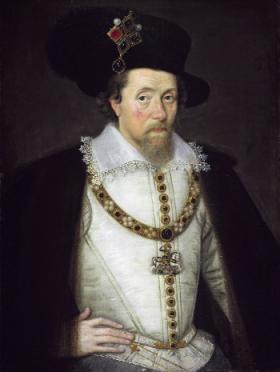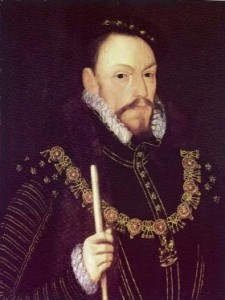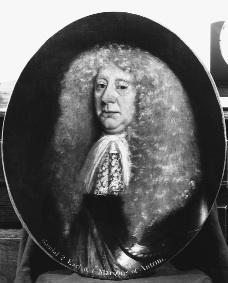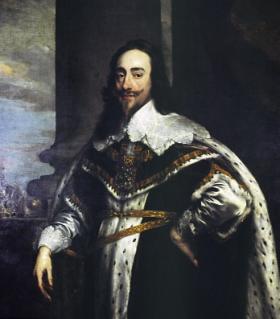A very British problem: the Stuart Crown and the Plantation of Ulster
Published in Early Modern History (1500–1700), Features, General, Issue 6 (Nov/Dec 2009), Plantation of Ireland, Volume 17
King James—ruled Ireland by virtue of being James I of England but his approach was that of James VI of Scotland. (Scottish Portrait Gallery)
In the Tudor period England had done its best to keep Scotland out of any dealings with the third of James VI and I’s kingdoms, Ireland. Those who had attempted plantations under Elizabeth did not want the Scots involved. The helpful offers of Archibald, earl of Argyll, in the 1560s to support the English viceroy in Ireland, Thomas, earl of Sussex, were treated with contempt—unwisely so, in view of Argyll’s links with Ireland and his enthusiasm for the Protestant cause.
Close ties between Ulster and the Scottish western highlands
Whatever England thought of the matter, geographical proximity and a shared language and culture—for Irish and Scottish Gaelic did not diverge until the seventeenth century—meant that Ireland, and in particular Ulster and the Scottish western highlands, had long and close ties, and these gave James VI and I the optimistic idea that he had a better understanding of his new Irish kingdom after 1603 than did his Tudor predecessors. Certainly the Tudors had failed in Ireland, and Elizabeth did not push any Irish policy, religious or secular, hard enough to have much, if any, chance of success. Yet her father, Henry VIII, in making himself king of Ireland in 1540 had created an entirely new constitutional position for the Irish, which in theory might have offered a way forward. Unfortunately, the Tudors naively believed that the root of the problem was that the original conquest of Ireland had not gone far enough (which was undoubtedly right) and that all that was needed was the relatively easy matter of completing it (which was undoubtedly wrong). Resurgent Gaelic lords, Old English and New English proved a virtually impossible mix, and the addition of the Scots after 1603, despite a less hostile and fearful Crown, in the long run complicated rather than reduced the problems.
Yet in 1603 the omens may have looked good. The new king might outrage his English subjects by refusing to be straitjacketed into the role of only king of England and, indeed, insisting on drawing on his Scottish experience, but it proved an intelligent policy in the fraught early years of the union of the crowns. For all their indignation, the English at last had a king with heirs, and for the Scots the fear of neglect was lessened, so on the whole the union had come to be accepted by the time of James’s death in 1625. As king of Ireland, James had the great potential advantage of not being an English king. For James, Ireland was his third kingdom, not a colony of England. His wariness of his Scottish Gaelic subjects might extend to his new Irish ones, but it certainly fell very far short of the assumptions of barbarity that had bedevilled the English Crown’s rule of Ireland. Moreover, he appeared to have a policy to offer, based on one he had pursued in the Western Isles: plantation.
Plantation of Ulster not what James set out to do

Thomas Radcliffe, third earl of Sussex, English viceroy in Ireland in the 1560s. Helpful offers of support from Archibald, earl of Argyll, were treated with contempt. In the Tudor period England had done its best to keep Scotland out of any dealings with Ireland. (National Portrait Gallery, London)
In fact, plantation was not James’s major policy, in Ireland any more than in Scotland. That great enterprise, the Plantation of Ulster, which began in 1609, represented not what the king set out to do but what he had failed to do. James was in many ways a traditional and conservatively minded king. Unlike Tudor monarchs, anxiously seeking to curtail and keep in check the power of the great landed aristocracy, James took a very positive line with his aristocrats. In his view, their power, if sometimes abused by individuals, was nevertheless crucial to the successful running of the kingdom, for they were, as he said in Basilikon Doron, ‘the armes and executers of your lawes’. That, of course, applied to the localities; but it was also the case that Jacobean government before 1603 was markedly more aristocratic than its Elizabethan counterpart, and the appearance after 1603 of what amounted to a noblesse de robe, drawn from the lairds and cadet branches of aristocratic families who had been pushing their way into central government, was a product of James’s move to London. In the Scottish highlands, therefore, the idea of plantation proved inconsequential compared to his continuation of the longstanding Scottish royal practice of using the Campbell earls of Argyll and the Gordon earls of Huntly as lieutenants, with none of the reluctance with which the English Crown had used the Kildares in Ireland in the late fifteenth and early sixteenth centuries. And the notable person here is George, sixth earl of Huntly, the leading Catholic earl and the king’s favourite.
Tyrone an Irish Huntly?
This style of kingship became very relevant to Ireland after 1603 in the person of Hugh O’Neill, earl of Tyrone. It was, as is well known, the sudden and dramatic Flight of the Earls in 1607 that opened the way for the Plantation of Ulster. That flight still retains an element of mystery and certainly puzzles me. In the first four years of his English rule, James did rush into a limited plantation policy, in Antrim and Down, which certainly benefited the Scots, but his plans for Ulster were very different and very striking. Here he applied a notably Scottish solution to the great Irish rebels of the last decade of Elizabeth’s reign. Put simply, he tried to turn Tyrone into the Irish Huntly.
It is impossible to imagine Elizabeth, at the end of the Nine Years’ War, treating Tyrone and Tyrconnell as James did. Elizabeth’s great rebel—like Huntly a Catholic, like Huntly a man who had made overtures to Philip II, the man who for nine years had threatened her rule of Ireland and tilted the balance against her ill-treated favourite Essex—was now treated with remarkable generosity. He had his earldom and lands restored, to the chagrin of Sir Arthur Chichester, who had looked for them for himself. Here was a Scoto-Irish policy with a vengeance. If this was the new British Crown in action, it seemed a very peculiar form of action to the English, for whom failed rebellion had long meant execution. In Scotland, which had considerably fewer full-scale rebellions and far fewer executions, the political and social dynamic was very different.

Randal MacDonnell, second earl and first marquis of Antrim. Not all those involved in the plantation were Protestant; Catholic Scots like MacDonnell were also favoured. (Viscount Dunluce)
So it looks as though James was importing into Ulster his belief that great local lords, even ones who might sometimes get out of hand as Huntly had done, were great local assets. Even Tyrconnell got his earldom back, though he had to wait until his rival Niall Garbh O’Donnell was no longer in favour.
At Tyrone’s urging and with the Unlike Tudor monarchs, backing of Mountjoy, whose own attitude to Tyrone changed markedly in the new reign, James did not appoint a lord president of Ulster. Moreover, Tyrone’s direct appeal to the king over his grievances and concerns brought a favourable response, as James requested that he or an agent should come to London, where king and council would arbitrate—in itself a very Scottish response. So while the situation in Ulster, its rivalries and divisions, cannot simply be equated with Scottish Gaeldom, for James, it seems, Tyrone and even perhaps the more dubious Tyrconnell were regarded as the best solution in Ulster, just as Huntly and Argyll were in the Scottish highlands. And surely Tyrone knew this: in 1607, just months before the Flight, he and Argyll arranged the marriage of Tyrone’s son to Argyll’s daughter.
Scottish solution to an Irish problem no longer possible
The problem of the Flight of the Earls, therefore, is not just a matter of explaining why Tyrone, instead of pushing his appeal to the king in London, as James encouraged him to do—and sending an agent if he were reluctant to risk his own person—abruptly panicked and joined Tyrconnell in flight. It may have been, for him, a huge mistake, because, unlike Scottish earls, Tyrone had only four years’ experience of the very different approach of the Scottish Crown, compared to long experience of the English. For James, however, it abruptly cut off a Scottish solution to an Irish problem; the Irish Huntly had gone. It is impossible to tell whether, had he remained, that solution would have worked. But now the only way forward was to move towards the massively ambitious Plantation of Ulster.
The Jacobean Plantation, however, was not the beginning of the establishment of Protestant Ulster. The influx of Scottish Presbyterians, with its long-term ramifications, lay in the mid-seventeenth-century future. The Scots were notable travellers, seizing opportunities wherever they presented themselves; as a medieval French proverb said, ‘Rats, lice and Scotsmen: you find them the world over’. But in the first half of the seventeenth century fewer Scots went to Ireland than to Poland, and fighting in the Thirty Years’ War had at least as great an appeal as settlement in Ireland. Nevertheless, Ireland did offer a new opportunity, and some took it. Some were Protestants, but some reflected James’s favour to the Catholic Scot Randall MacDonnell and the Catholic Irish Tyrone. From south-west Scotland came Catholics, planted by the earl of Abercorn and Sir George Hamilton in Strabane, while some Scots from Ayrshire converted to Catholicism.
This was not Protestant Ulster, and it is unlikely that James ever intended it to be. For King James was an ecumenist to his fingertips, that most unusual of early modern rulers, one who was not afraid of differing beliefs; rather, he was repelled by those who could not countenance differing beliefs. The Protestant James brought to Ireland an approach that was not just insufficiently determined but was positively confusing when, for example, his 1613 Irish parliament was not the hoped-for put-down of the Catholics. Nor did he simply pursue a policy of putting in English or Protestant Irish bishops. To the bishopric of Raphoe came two Scots, Andrew Knox and John Leslie, both former bishops of the Isles. The choice of Knox is particularly interesting because in 1609 James in partnership with Knox gave up on the pathetic little plantations in Scotland and turned to the Statutes of Iona, the first step in the gradually successful policy of bringing clan chiefs into the culture and language of the lowlands. At this point, however, Scottish and Irish policy diverged, as plantation roared ahead in Ireland. In Scotland, it was the reverse: chiefs signed up to the Statutes to avoid plantation. But in both contexts James trusted that Knox was a man who could work effectively, through a mixture of gentle persuasion and gentle blackmail, with his Gaelic subjects in Scotland and Ireland.
The fatal ‘British problem’

Archibald Campbell, marquis of Argyll. In the Scottish highlands plantation proved inconsequential compared to the continuation of the long-standing Scottish royal practice of using the Campbell earls of Argyll and the Gordon earls of Huntly as lieutenants, with none of the reluctance with which the English Crown had used the Kildares in Ireland in the late fifteenth and early sixteenth centuries. (British Museum)
Tudor policy in Ireland had failed. So also did the policy of the first Stuart king. But there was a difference. Despite the problems uncovered by the survey of the plantation in 1622, Jacobean Ireland was surely a less fraught society than Elizabethan Ireland had been. The failure was the result of what happened next. With Charles I’s drive for political and religious uniformity throughout the three Stuart kingdoms, the issue moved from plantation to the much more dangerous, and ultimately fatal, ‘British problem’. And it would take much tougher measures in the mid-seventeenth century for the Cromwellian government to get a grip on Ireland, at the very time when rampant Presbyterianism permanently changed the nature of the Plantation of Ulster. James’s reign was in fact a quite exceptional period. It is arguable that there was no solution to Ireland, not because of the British Crown but because of the English Crown, which annexed Wales, failed to annex Scotland, and did not try to complete its annexation of Ireland until religious division and an intolerable level of contempt by the annexing power ensured a bloody outcome. James ruled Ireland by virtue of being James I of England, but his approach was that of James VI of Scotland. Briefly that offered a new hope of success. Sadly, after 1625 it was once again an English king, and then an English gentleman, who brought their very different perspectives to bear on the problem, as they saw it, that was Ireland. HI
Jenny Wormald is an Honorary Fellow at the University of Edinburgh.
Further reading:
W.P. Kelly & J. Young (eds), Scotland and the Ulster plantations: explorations in the settlement of Stuart Ireland (Dublin, 2009).
H. Morgan, Tyrone’s rebellion (London, 1993).
J.H. Ohlmeyer (ed.), Political thought in seventeenth-century Ireland: kingdom or colony (Cambridge, 2000).
M. Perceval-Maxwell, The Scottish migration to Ulster in the reign of James I (Belfast, 1990).

Charles I—his drive for political and religious uniformity throughout the three Stuart kingdoms moved the issue from plantation to the much more dangerous, and ultimately fatal, ‘British problem’. (Scottish National Portrait Gallery)
















